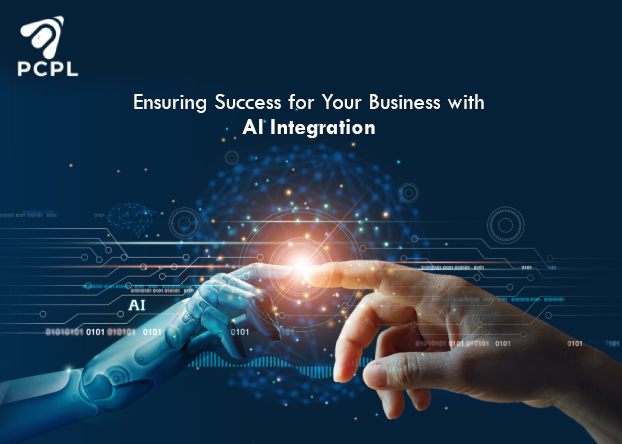
Ensuring Success for Your Business with AI Integration
The adoption of Artificial Intelligence (AI) is essential for companies aiming to stay competitive and innovative. Every decision and each step of the integration process can significantly impact the final outcome.
A recent Gartner study found that over 40% of companies that invested in AI technologies without a clear strategy ended up exceeding their budget. So, how can you fully harness the benefits of AI while steering clear of potential pitfalls? How do you ensure a smooth transition and seamless integration?
The path to successful AI integration can be complex and fraught with challenges. This blog will guide you through the essential steps and considerations for effectively integrating AI into your business operations, ensuring that you leverage its full potential for success.
Benefits of AI
Before learning about the integration process, it’s crucial to understand how AI can benefit your business.
- Enhance Decision-Making– AI algorithms can analyze vast amounts of data quickly and accurately, providing insights that support better business decisions.
- Improve Efficiency– Automation of routine tasks reduces human error and frees up employees to focus on more strategic activities.
- Personalize Customer Experience– AI can analyze customer behavior and preferences to deliver personalized experiences, improving customer satisfaction and loyalty.
- Drive Innovation– AI opens up new possibilities for products and services, enabling businesses to innovate and stay ahead of the competition.
Steps to Successful AI Integration
Now that you know the benefits that your business is going to get with the integration of AI, here are the steps that you need to follow for a smooth integration of the same.
- Define Clear Objectives
First of all, have a clear understanding of what you want to do with AI. Whether it’s improving customer service, optimizing supply chain management, or enhancing marketing efforts, defining your objectives will guide the integration process and help measure success.
- Assess Readiness and Resources
Evaluate your current infrastructure, data quality, and technological capabilities. Determine whether you have the necessary resources, including skilled personnel, data storage, and processing power. This assessment will highlight any gaps that need to be addressed before integration.
- Choose the Right AI Solutions
Not all AI solutions are created equal. Select technologies that align with your business objectives and integrate seamlessly with your existing systems. Consider factors such as scalability, ease of use, and support services when choosing an AI vendor.
- Invest in Data Management
Data is the backbone of AI. Make sure you have the best data management practices in place. This includes collecting high-quality data, maintaining data privacy and security, and setting up processes for continuous data update and cleansing.
- Develop a Pilot Program
Start with a small, manageable project to test the feasibility and impact of AI. A pilot program allows you to identify potential issues, gather feedback, and make necessary adjustments before a full-scale rollout. Ensure you have clear metrics to evaluate the success of the pilot.
- Foster a Culture of Collaboration
AI integration requires collaboration between different departments, including IT, operations, and management. Foster a culture where employees are encouraged to share insights and work together to ensure successful AI adoption. Provide training and resources to help staff understand and leverage AI tools effectively.
- Monitor and Iterate
AI integration is an ongoing process. Monitor the performance of AI systems on a regular basis and gather feedback. Use this information to iterate and improve your AI strategies. Stay updated with the latest advancements in AI technology to keep your business at the forefront of innovation.
Overcoming Common Challenges
But as we all know, no great thing comes without some roadblocks hitting the way. Integrating AI into your business processes also comes with its share of challenges and you should stay aware of these before you make any decision.
- Data Privacy and Security
AI systems rely on large datasets, which often include sensitive information. Ensuring data privacy and security is paramount. Implement stringent data protection measures and comply with relevant regulations, such as GDPR or CCPA.
- Integration with Legacy Systems
Integrating AI with your existing legacy systems can pose a challenge. Work with vendors who offer integration support and consider adopting middleware solutions that facilitate smooth data flow between old and new systems.
- Skill Gaps
A shortage of skilled AI professionals can hinder your integration efforts. Invest in training programs to upskill your existing workforce and consider partnering with educational institutions or AI vendors to access specialized expertise.
- Managing Change
AI integration often involves significant changes to workflows and job roles, which can meet with resistance from employees. Effective change management strategies, clear communication, and involving employees in the integration process can help mitigate resistance and ensure a smoother transition.
Measuring Success
To determine the success of your AI integration, establish clear Key Performance Indicators (KPIs) aligned with your objectives. These include
- Operational Efficiency– Metrics such as reduction in processing time, cost savings, and improved accuracy.
- Customer Satisfaction– Improvements in customer feedback scores, increase in customer retention rates, and growth in customer base.
- Financial Performance– Revenue growth, increased profit margins, and return on investment (ROI) from AI initiatives.
- Innovation and Growth– Number of new products or services developed, market share growth, and business expansion into new areas.
Regularly reviewing these metrics will help you assess the impact of AI on your business and make informed decisions about future AI investments.
Future Trends in AI
Staying ahead of the curve involves keeping an eye on emerging trends in AI technology. Rest assured that if you are investing in AI, your business is going to benefit from the future trends as well, which are
- Edge AI– Processing data closer to where it is generated (e.g., IoT devices), reducing latency and improving real-time decision-making.
- Explainable AI– Developing AI systems that provide transparent and understandable insights, enhancing trust and compliance.
- AI Ethics and Governance– Increasing focus on ethical AI use and robust governance frameworks to address bias, fairness, and accountability.
- AI-as-a-Service (AIaaS)– Growing adoption of cloud-based AI services that offer scalable and cost-effective solutions for businesses of all sizes.
Concluding thoughts
Integrating AI into your business can drive significant improvements in efficiency, decision-making, customer experience, and innovation. However, the journey requires careful planning, a clear understanding of objectives, robust data management, and a collaborative approach.
Move forward through these steps thoughtfully and overcome common challenges, to help your business harness the transformative power of AI for sustained success. Stay informed about future trends and continuously refine your AI strategies to keep pace with the evolving technological landscape.
